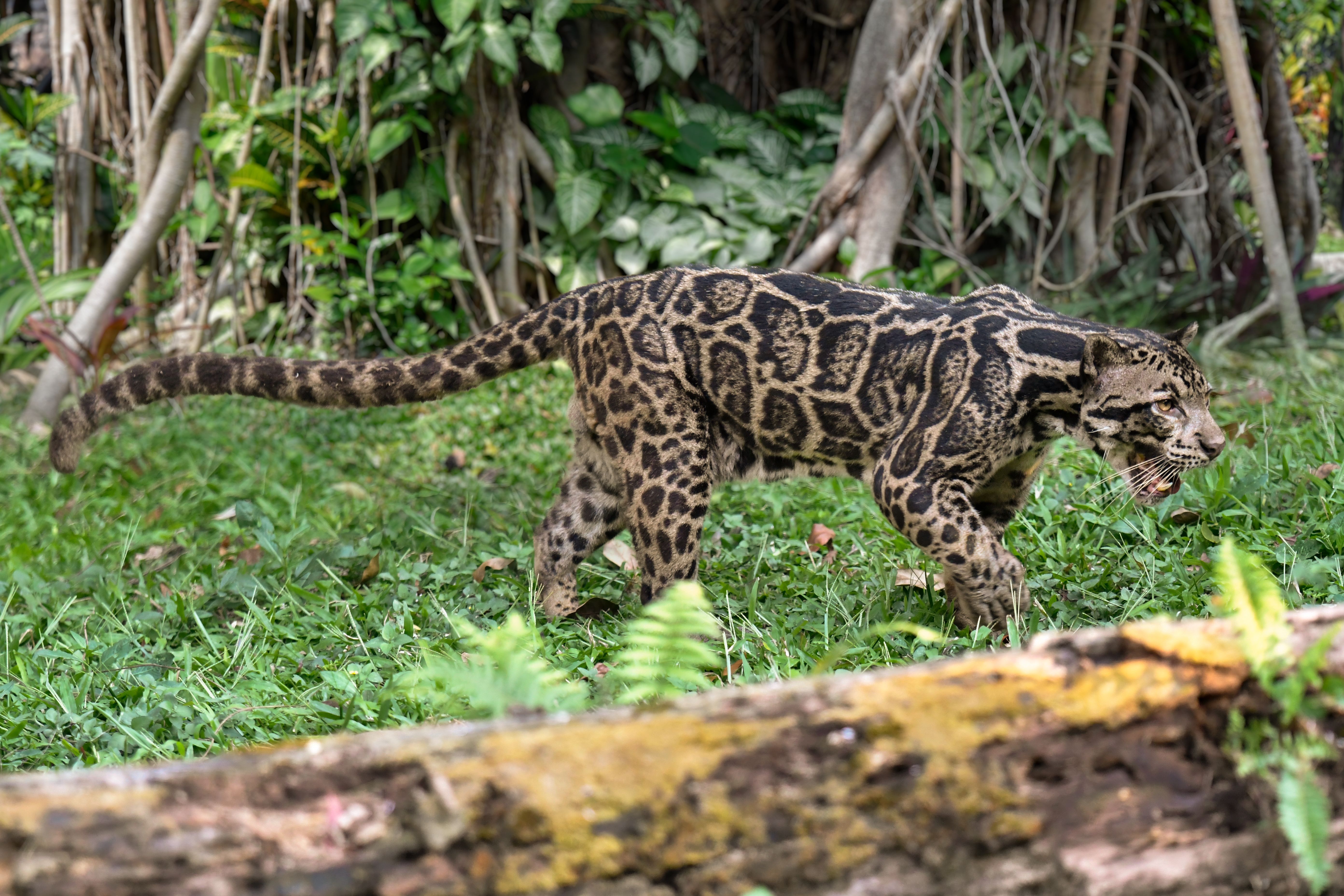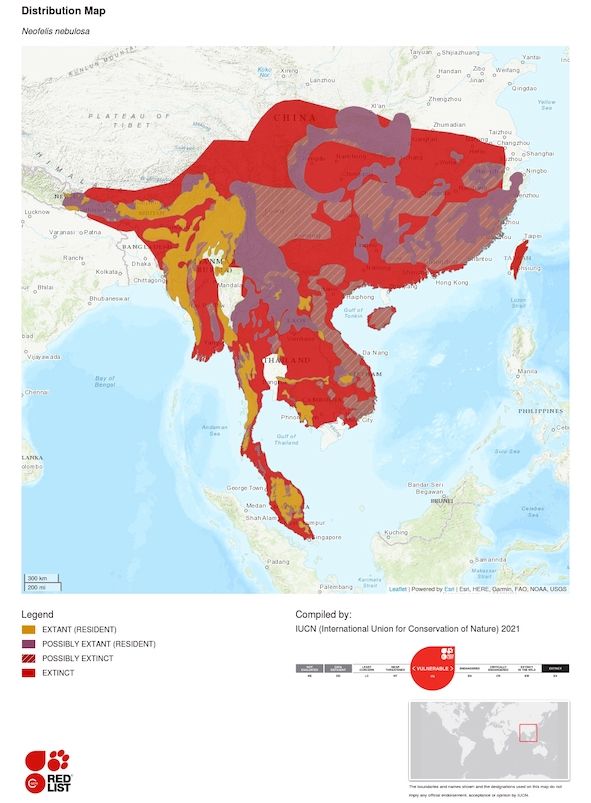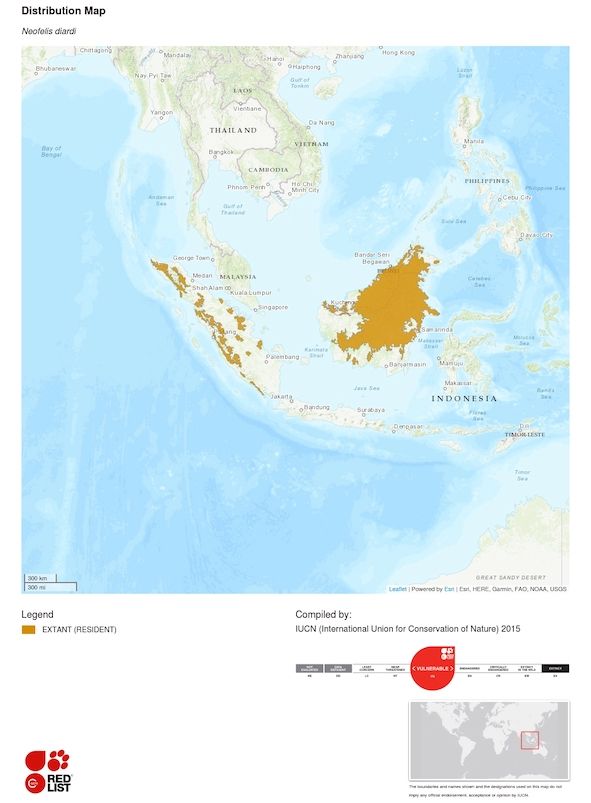SAVE WILD CATS FOUNDATION
New systematic classification - Sunda clouded leopard
Recent reclassification
The genus Neofelis is one of the least understood taxa among the felids and depletion of their forested habitats puts it under heavy pressure. Recently reclassification of Bornean clouded leopards (N. nebulosa diardi) to species level (N.diardi) was suggested based on molecular and morphological evidence.
Classically considered a single species, the Clouded Leopard has been split into two species. Based on analysis of mitochondrial DNA, microsatellites and morphology, Neofelis nebulosa is restricted to mainland Southeast Asia, and Neofelis diardi is found on the islands of Sumatra and Borneo. Based on analysis of genetic, skull and pelage characteristics, two distinct subspecies of Neofelis diardi have been recognized the Sumatran Clouded Leopard Neofelis diardi diardi and the Bornean Clouded Leopard Neofelis diardi borneensis.
Description
The clouded leopard is of intermediate size (comparable to a small leopard) with a tail nearly as long as the head and body, and relatively short legs. The clouded leopard has some very special characteristics: Its legs are short, stout and end in broad paws. Underside white with black spots. The hind legs are longer than the front ones and its tail thick and plush, covered proximally with spots and becoming encircled with black rings toward the tip. Head is long, crown spotted, rostrum white, dark stripes from the eye and the corner of the mouth. Together with its sister species the Sunda clouded leopard, its canine teeth are proportionally longer than those of any other extant cat. Males are larger than females.
Clouded leopard (N. nebulosa)
The patterns of its coat with cloud-like rosettes with dark outlines and lighter centres on a light background are unique and gave the clouded leopard its name. Pelage is light yellow to light gray. Underside white with black spots. Two broken black stripes along the spine and six longitudinal black stripes on the neck, starting behind the ears.

Sumatran clouded leopard (N. diardi diardi)
N. diardi has smaller markings and darker fur than N. nebulosa. Pelage is gray to tawny-gray, with relatively small, irregular blotches with thick, black margins and small black spots within each blotch. Two broken black stripes along the spine. Lower legs with solid, black blotches, closely clustered.

Bornean clouded leopard (N. diardi borneensis)
Overall darker, with a ground color grayer than that of the Sumatran Clouded Leopard, with yellowish tinge, more frequent and bolder cloud spots, larger, more angular cloud-like blotches, with thicker black borders, neck and shoulder stripes thicker. Two broken black stripes along the spine. Lower legs with solid, black blotches, closely clustered.

Diet
Clouded leopard (N. nebulosa)
Arboreal and terrestrial prey (hog deer, slow loris, brush-tailed porcupine, pangolin ground squirrel, primates, muntjac, pheasants); they occasionally kill poultry; apparently not interested in carrion.
Sunda clouded leopard (N. diardi)
Small to medium-sized mammals (primates, sambar, muntjac, bearded pig, mouse-deer, porcupines), and fish.
Geographic range
The Mainland Clouded Leopard is found from the Himalayan foothills in Nepal through Mainland Southeast Asia into China. Mainland Clouded Leopard is extinct on the island of Taiwan and numbers are very low, and the species may be close to extirpation, in Viet Nam, China, and Bangladesh.

The Sunda Clouded Leopard is found on the islands of Sumatra and Borneo. It is unknown if there are still Sunda Clouded Leopards on the small Batu Islands close to Sumatra.

Habitat
Clouded leopard (N. nebulosa)
Strongly associated with forest habitat, particularly primary evergreen tropical rainforest, but there are also records from dry and deciduous forest, as well as secondary and logged forests, grassland and scrub, and mangrove swamps, up to 2,200 m in the Himalayas. It shows a preference for forest over more open habitats.
Sumatran clouded leopard (N. diardi diardi)
It seems to be more abundant in hilly, mountain areas than at lower elevations, but it is found in a range of forest types. Forest dependent, including disturbed forest, so long as it has high canopy closure. Oil palm plantations and areas with low canopy closure are avoided
Bornean clouded leopard (N. diardi borneensis)
A range of forest types: primary lowland, upland, and submontane forest, selectively logged forest, peat-swamp forest, coastal mangroves, up to 1,500 m. Forest dependent, including disturbed forest, so long as it has high canopy closure. Oil palm plantations and areas with low canopy closure are avoided.
Numbers
The number of adults of N. nebulosa is estimated at 2700-5500 and N. diardi at 4500 individuals. Other sources estimate the population size of N. diardi subspecies - in the case of N. diardi diardi at 500 individuals, N. diardi borneensis at 3000. The current population trend of both species is decreasing.
Final thoughts
The different species N. nebulosa and N. diardi, as well as the two distinct populations on Borneo and Sumatra, should be managed separately, to protect the genetic diversity upon which future evolutionary potential depends. There’s a huge importance of taxonomic splitting for conservation, because the two species and the distinct populations on Borneo and Sumatra face a much greater risk of extinction, due to smaller distribution ranges, than previously assessed based on the former classification.
References
Wilting, A., Buckley-Beason, V.A., Feldhaar, H. et al. Clouded leopard phylogeny revisited: support for species recognition and population division between Borneo and Sumatra. Front Zool 4, 15 (2007);
Gray, T., Borah, J., Coudrat, C.N.Z., Ghimirey, Y., Giordano, A., Greenspan, E., Petersen, W., Rostro-García, S., Shariff, M. & Wai-Ming, W. 2021. Neofelis nebulosa. The IUCN Red List of Threatened Species 2021;
Hearn, A., Ross, J., Brodie, J., Cheyne, S., Haidir, I.A., Loken, B., Mathai, J., Wilting, A. & McCarthy, J. 2015. Neofelis diardi. The IUCN Red List of Threatened Species 2015;
Castelló JR. Felids and Hyenas of the World: Wildcats, Panthers, Lynx, Pumas, Ocelots, Caracals, and Relatives. 2020